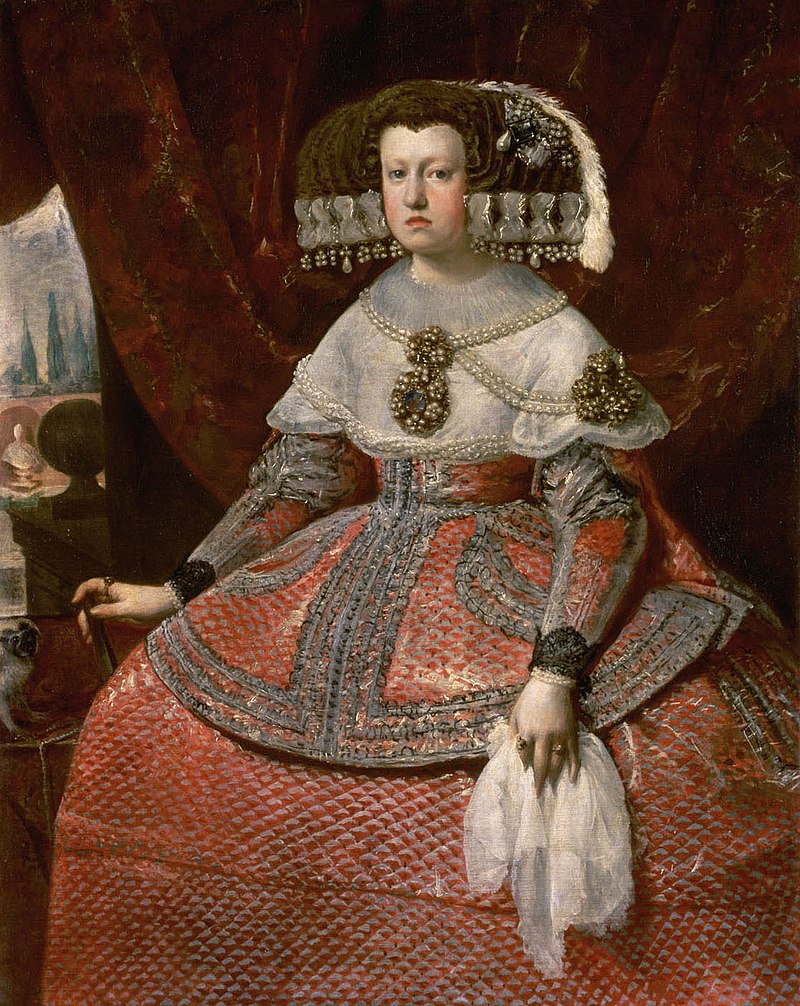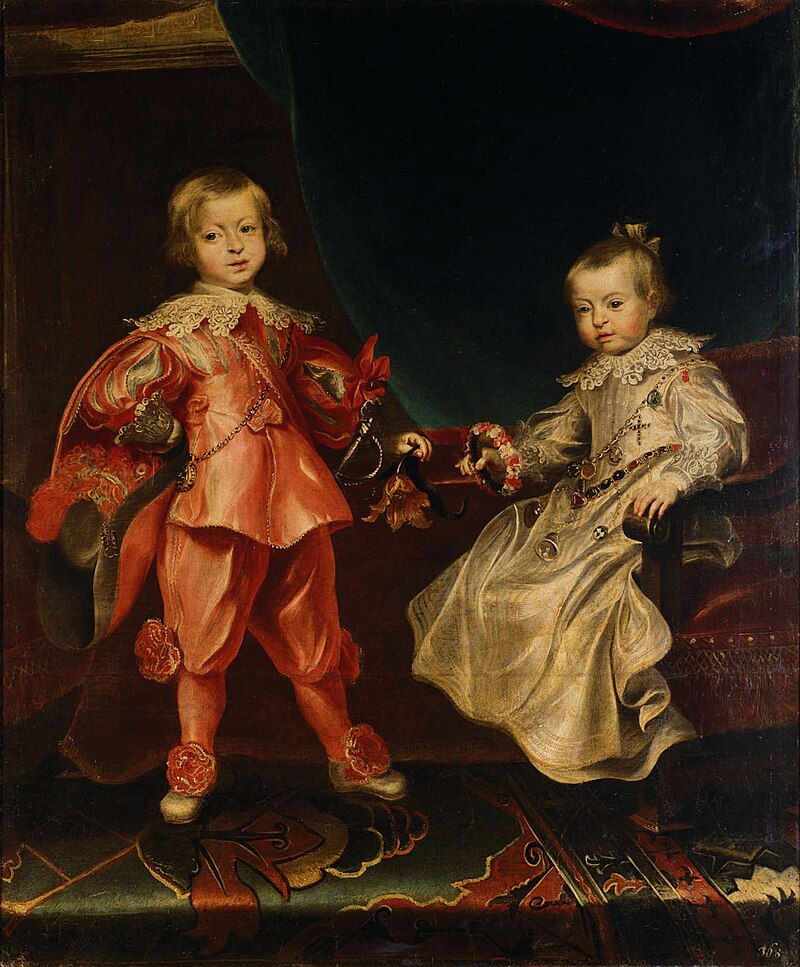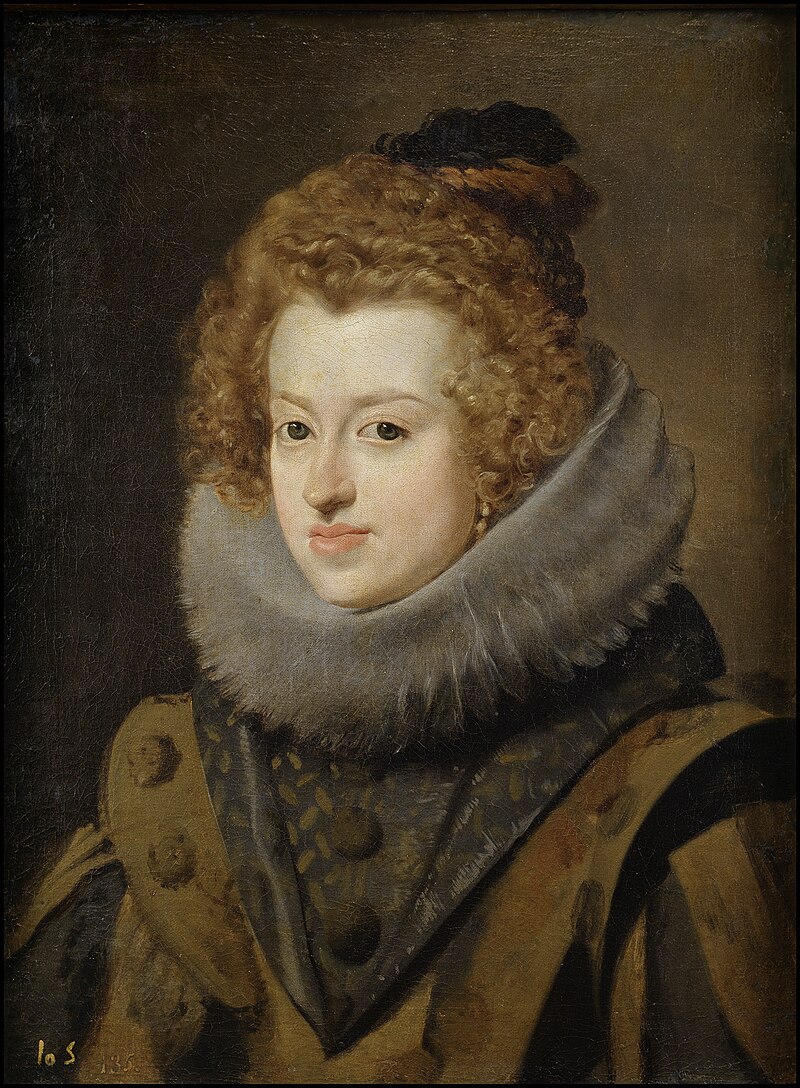by Susan Flantzer
© Unofficial Royalty 2022

Mariana of Austria, Queen of Spain; Credit – Wikipedia
Mariana of Austria was the second wife of her uncle Felipe IV, King of Spain, and Regent of Spain for her son Carlos II, King of Spain from 1665 – 1675. Born Maria Anna of Austria (she was called Mariana after her marriage to Felipe IV) on December 24, 1634, in Wiener Neustadt, Archduchy of Austria, Holy Roman Empire, now in Austria, she was the second of the six children and the elder of the two daughters of first cousins Ferdinand III, Holy Roman Emperor, King of Hungary and Croatia, King of Bohemia, Archduke of Austria and his first wife Maria Anna of Austria, Infanta of Spain and Portugal. Her paternal grandparents were Ferdinand II, Holy Roman Emperor, King of Hungary and Croatia, King of Bohemia, Archduke of Austria and his first wife Maria Anna of Bavaria. Mariana’s maternal grandparents were Felipe III, King of Spain and Margaret of Austria.

Mariana, on the right, with her brother Ferdinand, circa 1636; Credit Wikipedia
Mariana had five siblings but only two of her siblings survived childhood:
- Ferdinand, King of the Romans (1633 – 1654), unmarried, died from smallpox
- Archduke Philip August of Austria (1637 – 1639), died in childhood
- Archduke Maximilian Thomas of Austria (1638 – 1639), died in infancy
- Leopold I, Holy Roman Emperor (1640 – 1705), married (1) his niece and first cousin, Mariana’s daughter Margarita Theresa of Spain, had four children but only one survived childhood, died in childbirth (2) Claudia Felicitas of Austria, had two daughters who died in infancy, died from tuberculosis (3) Eleonor Magdalene of Neuburg, had ten children
- Archduchess Maria of Austria (born and died 1646), died in infancy


Mariana’s parents Holy Roman Emperor Ferdinand III and Maria Anna of Spain; Credit – Wikipedia
When Mariana was twelve-years-old her 39-year-old mother died. On May 12, 1646, Mariana’s pregnant mother Maria Anna suddenly felt ill with a fever and heavy bleeding. She died the next morning, and her unborn child, a girl named Maria, was delivered by cesarean section but she lived only a few hours.
In 1648, Mariana’s father married sixteen-year-old Maria Leopoldine of Austria-Tyrol, daughter of Leopold V, Archduke of Further Austria and Claudia de’ Medici. A year later, Maria Leopoldine died in childbirth giving birth to Mariana’s half-brother who died at the age of fourteen:
- Archduke Karl Joseph of Austria (1649 – 1664), died in his teens
In 1650, Mariana’s father made a third marriage to 21-year-old Eleonora Gonzaga, born a Princess of Mantua, Nevers, and Rethel. Eleanora was the daughter of Carlo Gonzaga, Duke of Nevers, the heir of the Duchy of Mantua, and his wife and cousin Maria Gonzaga, heiress to the Duchy of Montferrat.
Mariana had four half-siblings from her father’s marriage to Eleonora Gonzaga but only two survived childhood:
- Archduchess Theresia Maria Josefa of Austria (1652 – 1653), died in infancy
- Archduchess Eleonora Maria of Austria (1653 – 1697), married (1) Michal Korybut Wiśniowiecki, King of Poland, no children (2) Charles Léopold V, Duke of Lorraine, had six children
- Archduchess Maria Anna Josepha of Austria (1654 – 1689), married Johann Wilhelm, Elector Palatine, had two sons who both died on the day of their birth, died from tuberculosis
- Archduke Ferdinand Josef Alois of Austria (1657 – 1658), died in infancy
The House of Habsburg was notorious for its inbreeding. The Habsburgs had built their empire by marriage and they wanted to keep the land they amassed all in the family, so they began to intermarry more and more frequently among themselves. In 1646, continuing the Habsburg practice of intermarriage, King Felipe IV of Spain, Mariana’s uncle, the brother of her mother, arranged a marriage for his son and heir Balthasar Carlos, Prince of Asturias with his first cousin Mariana. However, Balthasar Carlos died three months later from smallpox, leaving his father with no male heir.

Mariana’s uncle and husband Felipe IV, King of Spain, circa 1644; Credit – Wikipedia
In 1644, Elisabeth of France, the wife of King Felipe IV of Spain, weakened by her multiple pregnancies and miscarriages, died at the age of forty-one, after miscarrying a son. After the death of his son Balthasar Carlos in 1646 left King Felipe IV with no male heir, he arranged to marry his son’s former fiancée Mariana. As Mariana was still young, the marriage was delayed. On October 7, 1649, the 44-year-old Felipe IV married his 14-year-old niece Mariana in Navalcarnero, outside Madrid, Spain. Of course, this marriage led to more inbreeding in the House of Habsburg.
Mariana and Felipe IV had five children but only two survived childhood:
- Margarita Teresa of Austria, Infanta of Spain (1651 – 1673), married her maternal uncle and first cousin Leopold I, Holy Roman Emperor, had four children, only one survived infancy
- Maria Ambrosia de la Concepción of Austria, Infanta of Spain (born and died 1655), died in infancy
- Felipe Prospero of Austria, Prince of Asturias (1657 – 1661), died in childhood
- Fernando of Austria, Infante of Spain (1658 – 1659), died in infancy
- Carlos II, King of Spain (1661 – 1700) married (1) Marie Louise d’Orléans, no children (2) Maria Anna of Neuburg, no children

Mariana and King Felipe IV’s son King Carlos II of Spain had a severe type of mandibular prognathism (Habsburg jaw); Credit – Wikipedia
The Spanish House of Habsburg would end with the reign of Mariana and Felipe IV’s physically and mentally disabled son Carlos II, King of Spain. While a person in the fifth generation normally has thirty-two different ancestors, Carlos II had only ten different ancestors in the fifth generation. Seven of his eight great-grandparents were descended from Juana I, Queen of Castile and León and her husband Philip of Habsburg, Duke of Burgundy. See the family tree of the ancestors of Carlos II, King of Spain at Wikipedia: Ancestors of Charles II of Spain. Carlos II’s Habsburg jaw (mandibular prognathism), a disfiguring genetic disorder in which the lower jaw outgrows the upper jaw, was so severe that he swallowed his food without thoroughly chewing. He did not learn to walk until he was eight and was unable to be educated as befitted the heir to the throne.
In early September 1665, Mariana’s husband Felipe IV began to feel unwell. His stools were bloody which meant he may have had dysentery. After great suffering, Felipe IV, King of Spain, aged 60, died on September 17, 1665, at the Royal Alcázar of Madrid, located at the site of today’s Royal Palace in Madrid, Spain. He was interred in the Pantheon of Kings at the Royal Basilica of San Lorenzo de El Escorial.
Mariana was appointed Regent for their nearly four-year-old son Carlos II, King of Spain. In his will, Felipe IV ordered the creation of a government commission consisting of carefully selected important people from politics, the church and, society to assist Mariana in her role as Regent of Spain. Although Mariana ceased to be Regent when her son Carlos II reached the age of 14 on November 6, 1675, due to Carlos’ physical and mental issues, Mariana remained an influential figure during his reign, until her death.
The Mariana Islands, an archipelago in the Pacific Ocean, were named after Mariana. In 1521, Ferdinand Magellan and his crew were the first Europeans to see the islands while on a Spanish expedition of world circumnavigation under Magellan’s command. In 1667, Spain formally claimed the islands as a colony and established a capital on the largest island, Guam. The following year, Mariana approved the establishment of a Jesuit mission on the islands under Blessed Diego Luis de San Vitores and Saint Pedro Calungsod. After the 1898 Spanish-American War, the Mariana Islands were ceded to the United States. Today, Guam is a United States territory and the Northern Mariana Islands are a commonwealth of the United States. The deepest trench in the Earth’s oceans, located to the southeast of the Mariana Islands, owes its name to Queen Mariana.

Mariana in her later years, circa 1683–1693; Credit – Wikipedia
Mariana survived her husband by thirty-one years, dying on May 16, 1696, at Uceda Palace in Madrid, Spain, at the age of sixty-one, probably from breast cancer. She was interred in the Pantheon of Kings at the Royal Basilica of San Lorenzo de El Escorial.

Tomb of Queen Mariana of Spain; Credit – De AldanaN – Trabajo propio, CC BY-SA 3.0, https://commons.wikimedia.org/w/index.php?curid=15342544
This article is the intellectual property of Unofficial Royalty and is NOT TO BE COPIED, EDITED, OR POSTED IN ANY FORM ON ANOTHER WEBSITE under any circumstances. It is permissible to use a link that directs to Unofficial Royalty.
Works Cited
- En.wikipedia.org. 2022. Charles II of Spain – Wikipedia. [online] Available at: <https://en.wikipedia.org/wiki/Charles_II_of_Spain> [Accessed 18 November 2022].
- Ferdinand III, Holy Roman Emperor (2022) Wikipedia. Wikimedia Foundation. Available at: https://en.wikipedia.org/wiki/Ferdinand_III,_Holy_Roman_Emperor (Accessed: November 18, 2022).
- Flantzer, Susan, 2022. Felipe IV, King of Spain, Filipe III, King of Portugal. [online] Unofficial Royalty. Available at: <https://www.unofficialroyalty.com/felipe-iv-king-of-spain-filip-iii-king-of-portugal/> [Accessed 18 November 2022].
- Mariana de Austria (2022) Wikipedia (Spanish). Wikimedia Foundation. Available at: https://es.wikipedia.org/wiki/Mariana_de_Austria (Accessed: November 18, 2022).
- Mariana of Austria (2022) Wikipedia. Wikimedia Foundation. Available at: https://en.wikipedia.org/wiki/Mariana_of_Austria (Accessed: November 18, 2022).
- Maria Anna von Österreich (1634–1696) (2021) Wikipedia (German). Wikimedia Foundation. Available at: https://de.wikipedia.org/wiki/Maria_Anna_von_%C3%96sterreich_(1634%E2%80%931696) (Accessed: November 18, 2022).
- Wheatcroft, Andrew (1995). The Habsburgs. London: Viking.
